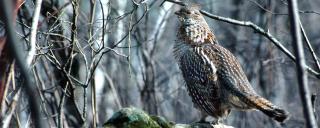
Ruffed Grouse Habitat
General Information
Ruffed grouse have slightly rounded tails, which are heavily barred and have a conspicuous black or brown band toward the tip. The tail band often is continuous in males and interrupted in females. Plumage is wood brown, gray or reddish-brown with white, black or buff y barring. Rusty or black ruffs occur on the sides of the neck and are more pronounced in males. Adults are 16-19 inches long and weigh from 1 to nearly 2 pounds. Ruffed grouse have two color phases, red and gray. This color difference can be seen in the body plumage, but is most pronounced on the tail.
During April and May, a male drums to proclaim his territory to other males and to relay his position to females. Drumming is performed daily from a favored log. Drumming logs are selected in areas of dense overhead canopy cover with good lateral visibility just above the ground. This type of area allows the male to see visiting females and it offers some protection from aerial predators. Males drum twice daily, at sunrise and in late afternoon. Upon arriving on the log, the male begins drumming, at first slowly beating his wings, increasing the tempo, and finally ending in a rapid whir. The drumming sound is produced on the backward stroke of each wing beat and is the result of compressed air.
Females visit different males before selecting a mate. A clutch of 10-12 eggs is laid at the base of a tree, log, or brush pile near a middle-aged clump of aspen. Incubation begins with the laying of the last egg and continues for 23-24 days. After the young hatch, all within one day, the female leads the brood away from the nest in search of food and shelter.
General Habitat Requirements
Typical ruffed grouse habitat in North Dakota is found in the aspen forests in the Turtle Mountains in Bottineau and Rolette counties and the Pembina Hills in Cavalier and Pembina counties. In northern latitudes, ruffed grouse seem to be tied to large expanses (over 640 acres) of aspen woodlands for both food and cover. Several age classes of aspen are needed for good grouse populations. Young aspen trees up to 10 years of age are used by broods; in these young forests, ground cover and associated insects are found in abundance. Middle-aged aspen stands (10-25 years) are used for food and winter cover. Older trees (60 years or older) are needed for resting, drumming and feeding. In these older areas, brushy undergrowth and the aspen produce good quantities of buds and catkins used as food. Chicks require a diet high in insects and other invertebrates for the first 7-10 days, after which they gradually shift to an adult diet of buds, catkins, fruits and berries. Adults continue to feed on buds and fruit in winter.
Management Considerations
- Aspen stands should be managed to provide a diversity of age classes within the normal home range of ruffed grouse.
- Avoid grazing in clear cut/managed stands until new trees are established (10 years and older).
- If grazing woodlands, a grazing plan should be implemented to protect a diversity of aspen age classes.
- Rejuvenate decadent stands by bulldozing or logging old trees (60 years and older)
- Reduce cropping/tillage along woodland edges to allow suckering of aspen.
- Control tall woody vegetation, including single trees that act as raptor perches and raptor nest sites.
